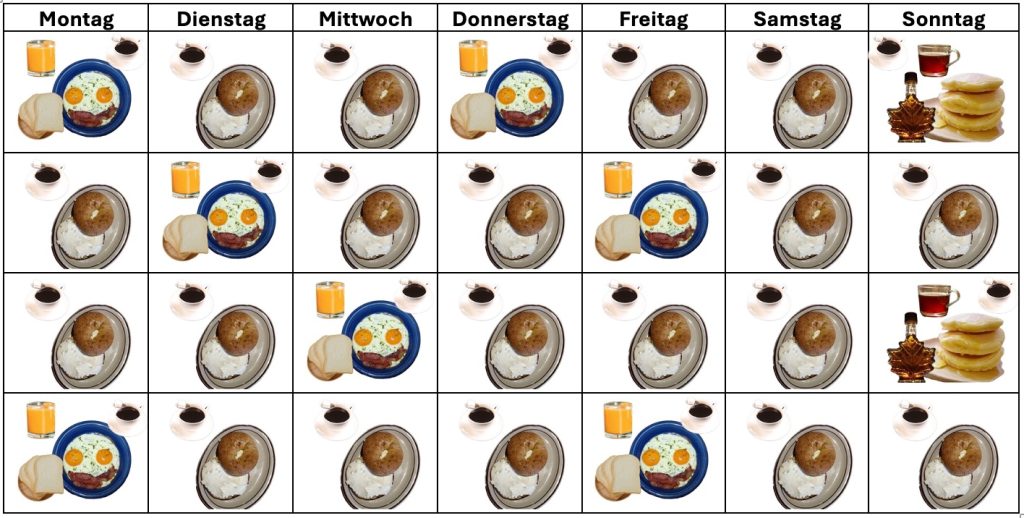6.5 Das ist ein schönes Frühstück!

Guten Morgen!
Zum Aufwärmen machen wir unseren Tagesminiplausch und eine Wiederholung.
Wiederholung
In the previous lesson, you learned how to say which beverages you prefer and how you like to drink them. Let’s review what you have learned.
Was trinkst du lieber? Was trinkst du am liebsten? In your written journal, write down all of the beverages you like. Now compare those drinks with each other. For example:
Ich trinke Wasser ohne Kohlensäure lieber als Cola mit Eiswürfeln. Ich trinke schwarzen Tee ohne Zucker am liebsten.
Lektionsüberblick
Frühstücken wie ein Kaiser, Mittagessen wie ein König und Abendessen wie ein Bettler. (Breakfast like an emperor, lunch like a king, dinner like a beggar.) This old German saying indicates that breakfast is considered a very important meal in the German-speaking countries. About three quarters of the population eat breakfast every morning (81% in Germany, 77% in Austria, 65% in Switzerland). The word Frühstück can be traced back to the 15th century and means something like the first piece of bread that is eaten in the morning. The English equivalent “breakfast” refers to breaking the nightly fast.
Now that we have reviewed and expanded on the basic food and drink categories, it is time to look at them in combination in meals. In the end, you will be able to 1) talk about the frequency with which you consume some breakfast foods, 2) say which breakfast foods you prefer over others, and 3) place emphasis in your speech.
Was weißt du schon?
| Noch nicht start klar?
Du kannst immer auf die gleiche 1010-Lektion zurückgreifen! |
Not confident about starting this lesson?
You can always review the same Lektion from 1010. |
1) Immer zum Frühstück
Wie oft ist du Cornflakes zum Frühstück? Wie oft trinkst du einen Kaffee? Many of us may eat the same breakfast every morning (jeden Morgen), while others may enjoy variety. Let’s first review the words for typical breakfast foods.
Do you remember how to talk about frequency? Let’s review! Look at the calendar of breakfast foods and sort the meals into the correct category in the following activity. Then sort the timing words (that do not exactly correspond to the calendar). After that you can practice putting sentences together.

Jetzt bist du dran!
2) Herzhaft oder süß?
Was isst du gern? Was isst du lieber? Was isst du am liebsten? What are your breakfast food preferences? Look at the following comparisons and then practice using the words for comparison. They should, by now, start feeling comfortable.
Jetzt bist du dran!
Hamburg im Blickpunkt

Hamburg hat fast 2.500 Brücken, die die zahlreichen Fleete, Flüsschen und Kanäle der Stadt überspannen. Damit hat sie mehr Brücken als Venedig (398) und Amsterdam (1.300).
Hamburg has almost 2,500 bridges, which span the city’s numerous canals, small rivers, and waterways. The city has more bridges than Venice (398) and Amsterdam (1,300).
3) Am liebsten esse ich…
One interesting feature about the German language is in its word order. If you want to emphasize something in German, you can usually just start your sentence with that emphasis. Look at the following sentences:
| Ich | esse | Müsli mit Joghurt am liebsten zum Frühstück. |
| Am liebsten | esse | ich Müsli mit Joghurt zum Frühstück. |
| Zum Frühstück | esse | ich Müsli mit Joghurt am liebsten. |
| Müsli mit Joghurt | esse |
ich am liebsten zum Frühstück. |
Do you notice a pattern in these sentences? Regardless of the emphasis, the verb is always in “second position”. The first sentence looks the most like English: When we start with a subject (= the person or thing doing the action, here: “ich“), the verb (= the doing part of the sentence, here: “esse“) follows. The other sentences do not follow English word order, which likes to keep putting the subject directly in front of the verb. As you can see here, if “ich” does not start the sentence, then it comes after the verb “esse”.
Let’s practice!
Check out So isst Deutschland, a 2015 study by Nutella about the breakfast habits of Germans. See how much you can understand by answering the questions below.
Jetzt bist du dran!
Zum Schluß

*As you conclude this lesson, don’t forget to check Canvas!*

Media Attributions
- Breakfast information adapted from Willkommen: Deutsch für alle, Copyright © 2020 by Claudia Kost and Crystal Sawatzky, licensed under the CC BY-NC-SA International License 4.0.
- So isst Deutschland comprehension questions adapted from Willkommen: Deutsch für alle, Copyright © 2020 by Claudia Kost and Crystal Sawatzky, licensed under the CC BY-NC-SA International License 4.0.
Media Attributions
- 1020-banner-large-reduced
- Screenshot

